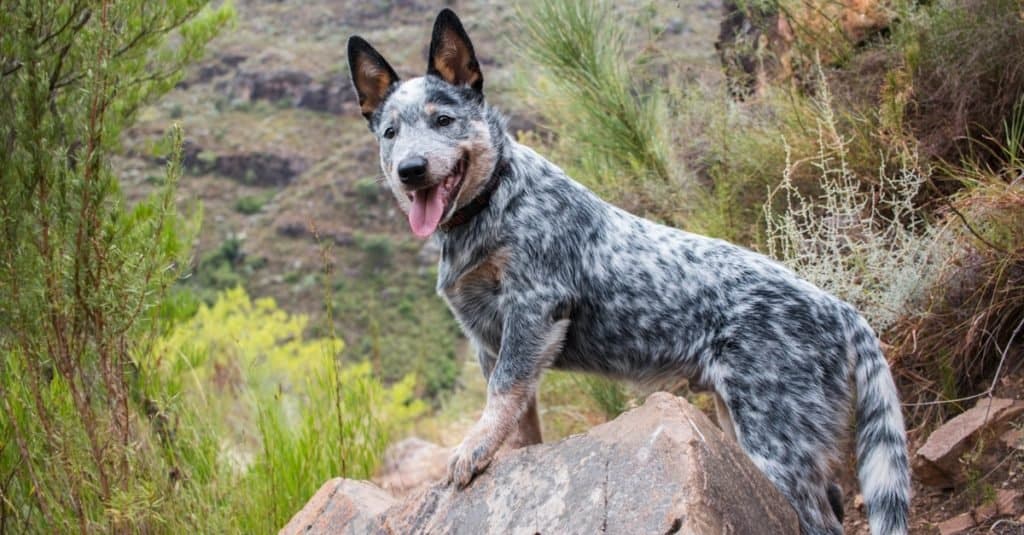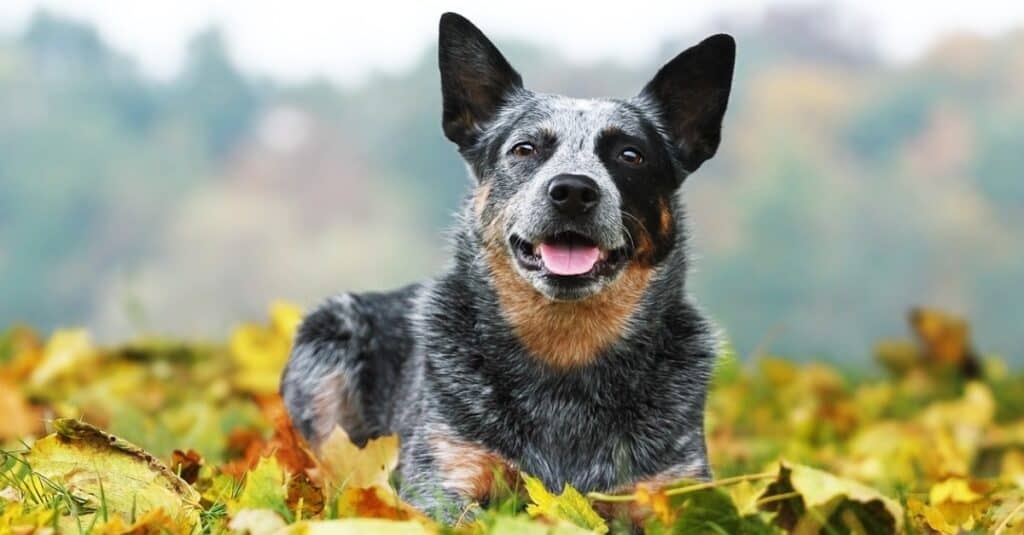Australian Cattle Dog vs Blue Heeler: Color

The Blue Heeler is the same breed as the Australian Cattle Dog. The only thing that can help you tell them apart is their color; the Blue Heeler has a blue coat. But how do they really get a blue-colored coat?
When they are born, Australian Cattle Dogs are completely white. Only the eyes and ears, sometimes also the tail and the back, are dark.
A Blue Heeler is born with some black spots; this is where everything begins. In time, when the puppy is around 4 weeks old, more and more black hair will start to blend with the white hair. Some of them can have more black hair; some can have more white hair. The amount of black hair influences the nuance of blue a Blue Heeler has as it grows older.

Australian Cattle Dog vs Blue Heeler vs Red Heeler: Color Variations
Depending on how and where the black hair spreads, the coat of a Blue Heeler can have several variations. It can be blue speckled or blue mottled.
The Blue Heeler that is blue speckled has a predominantly black color on its coat. The white color is spread in small and uneven groups, looking like white stains.
The blue-mottled variation has more white than black on the coat. This time, the coat appears white, with small black spots.
To help you differentiate the Australian Cattle Dogs further, let us tell you that there’s also a Red Heeler variation. As a puppy, the Red Heeler variation has brown hair growing on its coat, as opposed to the blue one, whose hair turns black.
There are also dogs that are a combination of the two. Some Red Heelers can have back hairs on their coat, and some Blue Heelers can have tan-colored hair on the face.

Blue Heeler Care
If a blue heeler does not get an outlet for its energy, it may become bored and destructive by chewing on shoes or furniture. This breed loves living in homes with a fenced yard or a safe property to run in. In addition, blue heelers don’t like to be left alone for long periods, especially in small spaces, so bring your pal along when going for a walk, hike, or swim.
Exercise is a critical part of a blue heeler’s life. Because of their hardworking heritage, the breed craves at least 30 minutes of regular physical exercise a day. A walk plus multiple games of fetch will tire out your blue heeler. This breed also needs at least 30 minutes a day of mental stimulation, so have a variety of puzzles, chews, and tug toys to help your dog stay satisfied. You can keep your dog entertained with a treat-dispensing puzzle or a rubber toy filled with peanut butter or another treat.
Blue heelers are not high maintenance. Bathe them as necessary, trim their nails once a month, brush their teeth, and clean their ears on occasion to promote wellness. This is not a breed prone to excessive drooling or doggy odor.
Their two-layered coats do need extra attention during times of the year when they do a lot of shedding, for example during the spring when they shed their winter coat. During this time, it’s important to brush your blue heeler frequently, sometimes multiple times a day, to remove dead hair. Youll need an undercoat rake or comb to do the best job.
The blue heeler is easy to train because they are intelligent and energetic. They will herd everything and anything that moves, including children and other pets. For this reason, blue heelers need early socialization and training to understand which behaviors are unacceptable. If early training is neglected, they may nip at running kids or play too rough with other animals.
These dogs often excel at canine sports such as agility, flyball, herding competitions, or obedience trials. Plus, the time spent training and interacting with your blue heeler is a good way to not only stimulate their mind, but also to further develop the bond between you and your pet.
:max_bytes(150000):strip_icc()/AustralianCattleDogfetch-Gettys-987190790-a1c3a18c6ebb4ae3b6978e14613b1eca.jpg)
:max_bytes(150000):strip_icc()/Australiancattledogherd-Gettys-629216412-89e40231dc384929bbc1047c04378601.jpg)
7 Reasons you SHOULD NOT get a Blue Heeler (Australian Cattle Dog)
Australian cattle dog, blue heeler, Australian heeler, Queensland heeler — the names are different but its the same dog, a tough guy who got his start in the Australian Outback. The Australian cattle dog is a mishmash of different dogs, specially brewed to be a valuable herding dog.
Back in the 1800s, cattle herding British emigrants to Australia found their Smithfield dogs werent holding up to the harsh conditions in the Outback. The Smithfields, with their thick, heavy coats, were well-suited for the cooler climates of the British Isles. However their natural insulation was too much for the Outback. As well, the now-extinct dogs had a tendency to bark too much and bite too enthusiastically to work with cattle. The cattlemen began experimenting with a variety of dogs in an effort to come up with the perfect herding dog for the Outback.